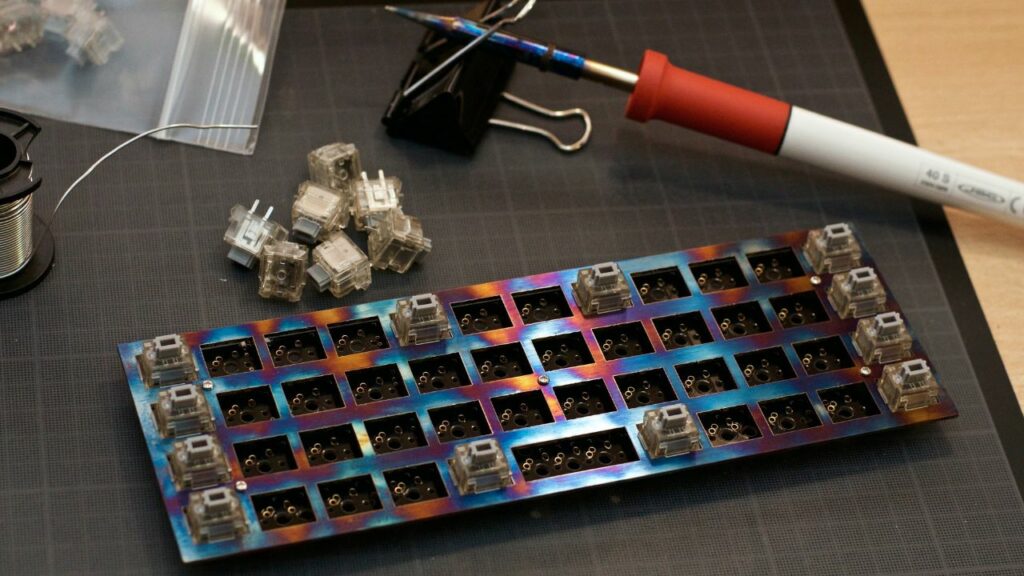Venturing into the realm of building your own keyboard? You’ll soon encounter a pivotal decision – hot-swap or solder printed circuit board (PCB)? Each comes with its own set of advantages and drawbacks, and the optimal choice often hinges on your personal tastes, budget, and knack for the task.
Getting Started: A Primer on Hot-swap and Solder PCBs

Before diving into the nitty-gritty of our keyboard showdown, let’s first understand what these PCB types entail.
hot-swap PCB is your ticket to effortless mechanical switch removal and replacement. There’s no need for powering down or halting your machine – simply use your hands or a switch puller tool to do the job. This convenience takes the hassle out of maintenance, but more importantly, it opens up a world of keyboard customization just for you.
Switching gears to solder PCBs, you’ll find they demand a bit more elbow grease. The process of extracting individual switches entails warming and removing solder, which may appear daunting to some of our DIY aficionados. Nevertheless, this method packs an added punch in terms of durability – it generally fosters stronger connections between components.
The Pros and Cons: Hot Swap VS Solder PCBs
Having brushed up on the essentials, let’s navigate through the pros and cons of both types of PCBs. This will help you understand what each offers, lending you a clearer perspective for your decision-making.
Hot-Swap PCBs: Easy Installation but Limited Models
The main allure of hot-swap keyboards lies in their ease of installation. If you’re new to keyboard customization or simply prefer convenience, hot swap is likely your best bet.
However, they do come with their share of drawbacks. For starters, hot-swap apparatus may wear out over time. This could lead to switches falling out—an inconvenience you certainly wouldn’t want while gaming. Moreover, due to their intricate construction process, hot-swappable keyboards tend to limit the number of models available on the market.
Soldered PCBs: More Layout Options but Requires Technical Skills
Solder models offer a range of layouts—perfect for those seeking extensive customization options. They also boast better durability due to fewer parts used in construction.
However, working with soldered PCBs requires some technical skills. You’ll need to heat up and remove solder whenever you want to change individual switches—a process that can be daunting for some gamers.
Hot Swap VS Solder PCB: Looking at the Cost Factor
In the debate of hot-swap versus soldered PCBs, your wallet might have a say. Generally, hot-swap keyboards command a higher price tag, courtesy of the extra parts needed for connectors and the hot-swap mechanism. While it might seem like a steep initial investment, consider the long-term benefits. Sometimes, splurging a little more upfront can be a time and effort saver in the future.
Energy Consumption: Hot Swap VS Solder PCB
Another point worth noting is that hot-swap PCBs require more energy to run than their soldered counterparts. This is because the connectors and hot-swap mechanism use additional power. However, in practice, this difference in energy consumption is likely to be negligible for most users.
The Size Factor: Comparing Hot Swap and Solder PCBs
In terms of size, hot-swap PCBs are generally larger due to the extra parts needed for the connectors and hot-swapping mechanism. This might be an essential consideration if space on your gaming desk is limited or if you prefer a sleeker design aesthetic.
Maintenance Aspect: Hot Swap VS Solder PCB
Maintenance is another aspect where hot-swap keyboards have an advantage. Since components can be swapped quickly and easily without affecting system functionality, they require less upkeep compared to soldered PCBs. This can save valuable time—especially for avid gamers who would rather spend their time playing than maintaining their equipment.
Frequently Asked Questions
How can I tell if a keyboard uses a hot swap or soldered PCB?
One way to determine this is by looking at the product specifications or user guide—if it mentions that components can be swapped without shutting down the system, it’s likely using a hot swap PCB. You can also refer to this guide for more information on how to determine if a keyboard is hot swappable.
Are all mechanical keyboards hot swappable?
No, not all mechanical keyboards are hot swappable. While many newer models come with this feature for added convenience, older or budget-friendly options may still use soldered connections. Here’s an excellent article that dives deeper into whether all mechanical keyboards are hot swappable.
Can I convert my soldered keyboard into a hot-swappable one?
While technically possible, converting a soldered keyboard into a hot-swappable one involves desoldering all switches and installing new ones with sockets—a task that requires considerable technical skills and patience.
Which one lasts longer: Hot swap or soldered keyboards?
Soldered keyboards usually last longer due to their more robust construction—the connection between components and board tends to be more reliable thanks to the soldering process. However, well-built hot swap keyboards can also offer years of service if maintained properly.
Making Your Decision: Which One Is Right For You?
So should you go for a hot swap or soldered PCB? Well, it depends on what you value most in a keyboard.
If ease of installation is your top priority or if you’re just starting out with keyboard customization, then hot swap might be an excellent fit for you—check out some of the best TKL hot-swappable keyboards here!
But if you’re the kind who prioritizes longevity and values a keyboard that can be tailored to your exact specifications, and you’re not one to shy away from a bit of hands-on work, then a soldered PCB model may just be the right fit for you.
In conclusion, whether it’s hot swap or soldered PCB—the ultimate decision lies in what makes your gaming experience most enjoyable! Happy gaming!